Without a doubt, Brie and Camembert are two of the world’s most famous soft cheeses. In this exploration, we delve into their unique stories, unravelling the subtle differences that make each a culinary masterpiece. Read on to discover the similarities and differences between Brie and Camembert.
SEE ALSO: The complete list of France’s most protected cheeses →
Similarities between Brie and Camembert
In the picturesque countryside of France, where rolling hills meet fertile pastures, Brie and Camembert share a heritage deeply rooted in tradition and craftsmanship. Despite their nuanced differences, they do have quite a bit in common.
1. Milk origin and type
Both Brie and Camembert are born from the wholesome goodness of cow’s milk. Sourced from pasture-fed cows, this high-quality milk forms the foundation of their creamy indulgence.
Traditionally, French farmers and artisans used raw milk to make both cheeses. But in modern times, there are a number of versions of both cheeses made in France and abroad that are pasteurised.
2. French craft and tradition
Rooted in centuries-old cheesemaking traditions, both Brie and Camembert undergo meticulous craftsmanship. Skilled artisans, carrying the wisdom of generations, lovingly curdle, mould and age these cheeses.
The process, steeped in history, reflects the dedication to preserving the authentic taste and texture that cheese connoisseurs have come to adore.
3. Protection by the AOP
Currently, there are two versions of Brie and one version of Camembert that are protected by an AOP stamp in Europe. Those are Brie de Meaux, Brie de Melun and Camembert de Normandie. And all three are made using raw milk.
Unlike their protected AOP counterparts in France, the names Brie and Camembert are not restricted by geographical boundaries. As a result, artisans and commercial producers around the world can name their soft cheese Brie or Camembert.
4. Soft white mould rind
The signature of both Brie and Camembert lies in their velvety, bloomy rinds. Both cheeses are enveloped in a delicate layer of white mould, which not only protects the interior but also imparts a distinct earthy flavour.
The rind of Camembert and Brie cheeses is formed by a type of mould called Penicillium candidum. During the cheesemaking process, the cheese curds are inoculated with this mould, which gradually grows on the surface, creating a soft, velvety rind.
This soft, edible rind encapsulates the cheeses’ richness, inviting cheese enthusiasts into a world of exquisite creaminess. You can learn more about which cheese rinds are edible in our comprehensive guide here.
5. Surface-ripened cheeses
Both Brie and Camembert are surface-ripened cheeses. What this means is that their ripening process starts under the rind and gradually progresses to the centre of the cheese.
The process starts from the rind because this is where the moulds are in direct contact with the cheese. Therefore, the paste closest to the rind softens first, becoming creamy and gooey, while the interior retains a firmer texture.
This contrast in textures is a hallmark of surface-ripened cheeses, providing a layered experience.
6. Rich creaminess and luxurious mouthfeel
When it comes to texture, Brie and Camembert share a divine creaminess that melts seductively on the palate. The pale-yellow velvety paste of both cheeses offers a luxurious mouthfeel, creating a sensory experience that cheese enthusiasts crave.
This indulgent creaminess is a testament to the high-quality milk used and the careful maturation process employed by artisans. Indeed, traditional versions of both cheeses present with around 45% of fat in dry matter.
7. Versatile ingredients in kitchens around the world
Brie and Camembert are celebrated for their versatility in the culinary world. Whether served at room temperature, baked until gooey, or incorporated into a variety of dishes, these cheeses elevate any recipe they grace.
Moreover, their ability to seamlessly blend into both sweet and savoury creations showcases their adaptability, making them cherished ingredients in kitchens around the globe.
Differences between Brie and Camembert
Delving into the world of Brie and Camembert, it becomes evident that beyond their white rinds and creamy texture, these cheeses boast an intricate tapestry of differences.
1. Geographical origin
While Brie and Camembert may share the same nation of origin, their roots delve into distinct regions of France.
Brie hails from the Île-de-France region, just outside Paris. Actually, that region was historically known as Brie, and that is where the cheese draws its name.
In contrast, Camembert finds its home in the picturesque dairy farms of Normandy. And the cheese owes its name to a small village in the region called (you’ve guessed it) Camembert.
Due to these differing landscapes, the cheeses develop subtle variations in flavour and aroma, reflecting the terroir in which they are crafted.
2. Date of creation
Brie boasts a heritage that stretches back to the 8th century, steeped in centuries of tradition. On the other hand, Camembert is a much more recent creation. Effectively, the earliest mentions of the latter only appeared in 1791.
The credit for Camembert’s invention often rests upon the shoulders of a resourceful farmer named Marie Harel. As the tale goes, she sheltered a priest named Abbot Bonvoust, who hailed from the Brie region.
In gratitude for her hospitality, the priest shared the secrets of making Brie cheese. Inspired by this knowledge and her own expertise, Marie Harel meticulously adapted the recipe, incorporating local techniques and the region’s distinct dairy character.
3. Size and weight
One of the most noticeable differences lies in their size.
Brie wheels are traditionally larger, often measuring around 35 cm (14 in) in diameter, while Camembert wheels are more petite, typically about 10 cm (4 in) in diameter. Additionally, most wheels of Brie weigh around 3 kg (6.6 lbs) while Camembert weighs around 250 g (0.5 lbs).
This variance in size influences the paste-to-rind ratio, affecting their textures and taste experiences.
Having said that, commercial versions of Brie made outside of France often present in the same size as Camembert.
4. Production methods
One of the pivotal distinctions between Brie and Camembert lies in their production methods, where even the subtlest of techniques can yield remarkable differences in taste and texture.
In crafting Camembert de Normandie, cheesemakers do not cut the curd to preserve moisture. When ladling the curd, they use deep ladles with no perforations.
Afterwards, they gradually fill the moulds, one ladle at a time, over the course of four hours. This process, coupled with light pressing under a metal plate, creates a densely textured young cheese.
On the other hand, artisans making Brie cut the curd, thus releasing more whey that is drained off. To do so, they use a unique ladle called Pelle à Brie that is shallow and perforated to fill up the moulds.
This process takes place more quickly than with Camembert and they leave the moulds to drain overnight without any additional weight, making for a less dense young cheese.
5. Maturation period
Brie and Camembert follow distinct maturation timelines. Brie undergoes a lengthier ageing process of four to eight weeks, allowing its flavours to mature and intensify over time.
On the other hand, Camembert has a shorter maturation period, usually around three weeks. Coupled with its lower paste to rind ratio, this shorter ageing imparts a slightly firmer texture to Camembert.
6. Fat content in commercial versions
While traditional versions of Brie and Camembert both clock in around 45% of fat in dry matter, many commercial versions of Brie tend to be creamier.
Due to the addition of cream during production, cheeses marketed as Double Cream Brie can contain between 60-75% of fat in dry matter. And Triple Creams exceed 75%!
7. Aroma and flavour profile
Brie boasts a mild, buttery aroma with subtle earthy undertones, offering a gentle introduction to its nuanced flavours. One of the signature aromas of Brie is mushroom and we explain the reason for this here.
Despite its shorter ageing period, Camembert develops a more pronounced aroma, reminiscent of mushrooms and hay, setting the stage for its bolder, earthy flavour profile. This is due to the use of a slightly stronger starter culture during cheesemaking.
8. How they are sold
Due to the differences in size, Brie and Camembert tend to present differently in grocers and cheese shops.
Camembert typically graces the shelves as a whole cheese, nestled snugly inside its iconic round wooden box. This packaging not only preserves the cheese’s delicate texture but also enhances its flavours, allowing it to mature gracefully.
In contrast, traditional Brie is most often sliced before you take it home. If you’re shopping in a supermarket, it will most probably be pre-sliced and wrapped in plastic. Conversely, in a specialty cheese shop, the cheese monger will cut a slice off a larger wheel when you place your order.
But, as we mentioned above, commercial versions of Brie often present in a small format. Hence, those are typically sold whole in supermarkets.
9. Food pairings
Thanks to its creamy and mild flavour profile, Brie harmonises beautifully with an array of accompaniments. Pair it with fresh fruits such as grapes, apples, or pears to contrast its richness with a hint of sweetness.
Additionally, Brie complements the crunch of nuts, especially walnuts and almonds, enhancing both texture and taste. When served with crusty bread or crackers, it creates a delightful contrast, adding depth to each bite.
For a more indulgent experience, combine Brie with honey or fruit preserves, elevating its delicate taste to gourmet heights.
In contrast, Camembert’s bold, earthy flavours invite creative pairings. Its robust taste contrasts wonderfully with the sweetness of dried fruits, such as figs and apricots, offering a complex blend of flavours.
To enhance its savoury notes, serve Camembert with an assortment of cured meats, like prosciutto or salami, for a delightful balance between saltiness and creaminess.
Also, freshly baked baguettes or bread provide an excellent canvas, letting the cheese’s texture shine.
Finally, experimenting with herbs like rosemary or thyme can also intensify Camembert’s aromatic qualities, transforming every bite into a culinary adventure.
10. Beverage pairings
Brie’s mild, buttery taste pairs wonderfully with a variety of beverages. Champagne or sparkling wine creates a delightful contrast, cleansing the palate with effervescence, while white wines such as Chardonnay or Sauvignon Blanc complement its subtle flavours.
For non-alcoholic options, consider serving Brie with green tea or sparkling water with a splash of citrus. The crispness of these beverages counterbalances Brie’s richness, ensuring a refreshing experience.
One drink you should avoid with Brie is red wine, and we’ve got the reason explained in this blog post here.
Conversely, Camembert’s earthy and robust nature calls for drinks that can stand up to its intensity. Dry red wines like Saint-Emilion or Moulin-à-Vent enhance Camembert’s flavours, creating a luxurious combination of tastes.
If you prefer beer, opt for a Belgian ale, which can complement Camembert’s depth with its malty notes.
But for us, the winner is Cidre de Normandie. Indeed, this dry cider pairs exceptionally well with Camembert, offering a delightful balance of sweetness and acidity.
Additionally, black or oolong tea, with their complex profiles, can accentuate the cheese’s earthy undertones, creating a sophisticated pairing experience.
Summary
In the grand finale of our culinary expedition, the enchanting world of Brie and Camembert unfurls its delightful secrets. These cheeses, rooted in the heart of France, epitomise the artistry of cheesemaking, each with its own unique tale to tell.
Brie, the epitome of sophistication, caresses the senses with its creamy texture and subtle flavours. Its elegant demeanour is a testament to the centuries-old French cheesemaking tradition.
On the other hand, Camembert, with its bold character and earthy notes, stands as a rustic artisan’s masterpiece, born from innovation and ingenuity.
In every bite of Brie and Camembert, we taste not just the cheese, but the essence of France itself—a land where passion, heritage and creativity meld in each wheel.
Whether you lean towards Brie’s delicate grace or Camembert’s bold embrace, both cheeses offer a sensory adventure, reminding us that every meal can be a journey through history and flavour.
So, which classic French soft cheese do you prefer? Let us know whether you’re on Team Brie or Team Camembert in the comments below.
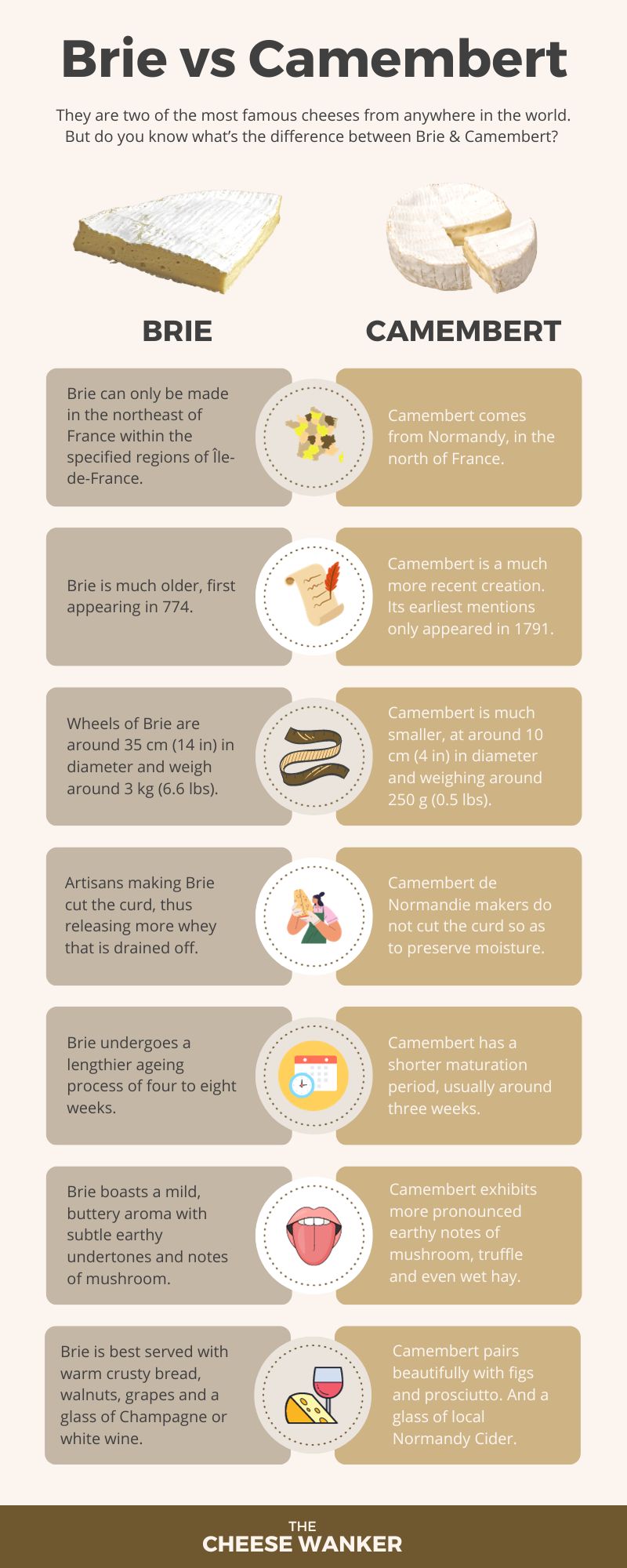
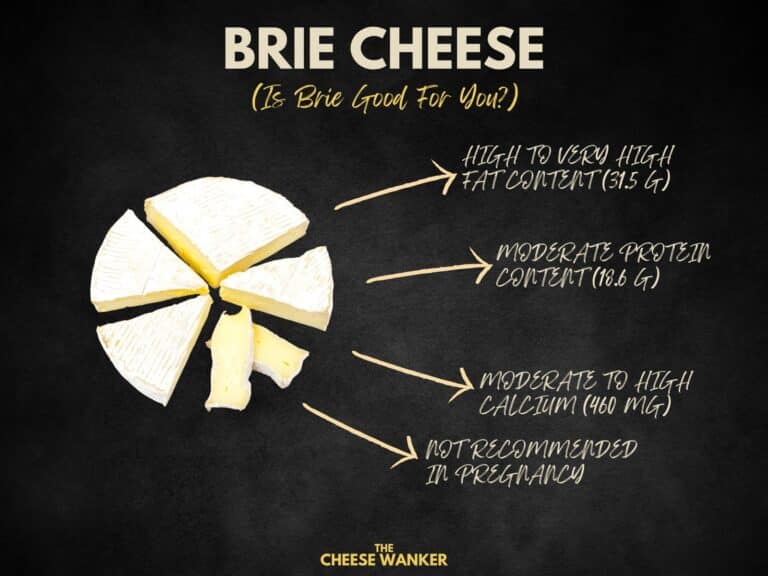
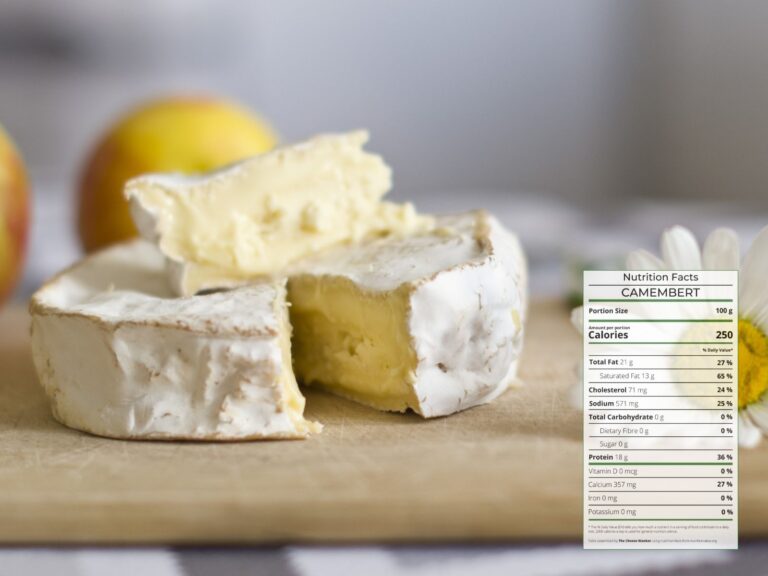
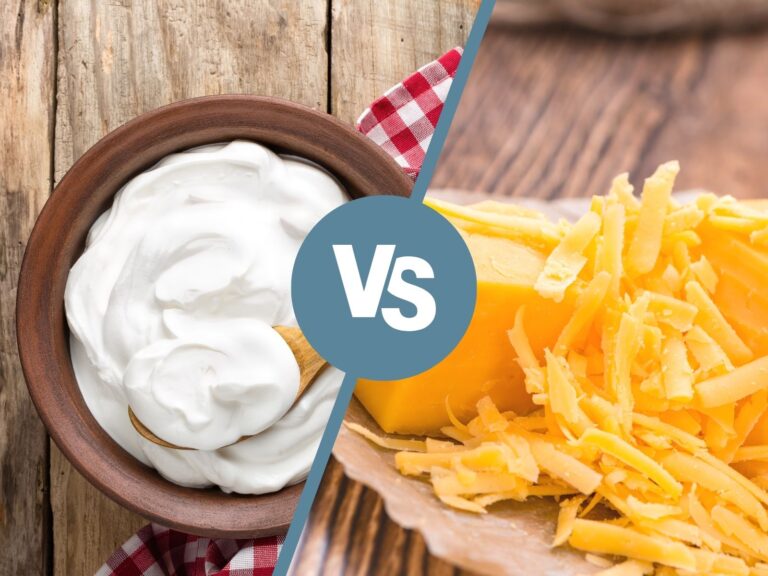
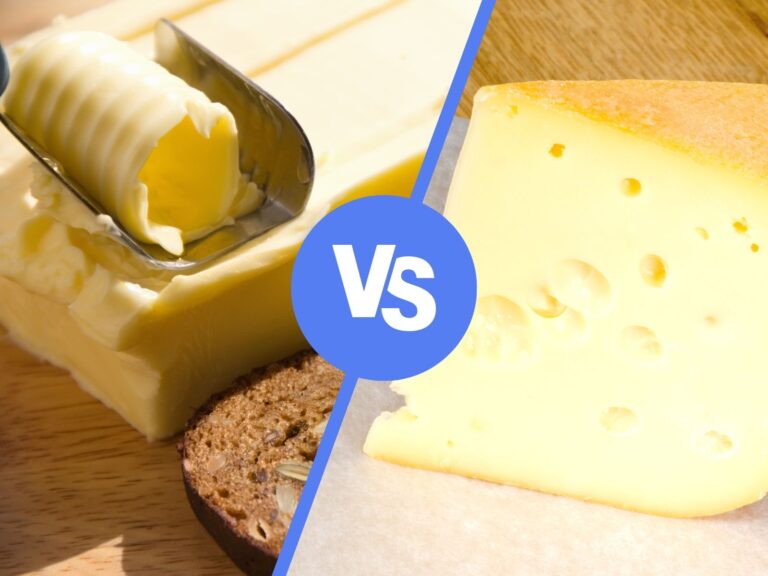
Novost
Thanks Cheese Wanker for great explanation of the difference between Brie and Camembert as it answered every question my useless teen had posed.
More power to your cheesiness.
Really glad we could help you Cheesy!
Thank you for your explanation. I am trying to make Camembert and Brie with Jersey cow milk (pasturised) and not having much success. Do you think this is because of the high fat content? Tastes good but it’s very chalky in the middle.
Hi Jo, thank you for reading our post and leaving a message. I know of at least one producer in Switzerland who makes a Camembert-style cheese using jersey milk (https://www.farmy.ch/fr-CH/jersey-camembert-koster). It is possible but can be challenging. They do use raw milk though. How long are you maturing both cheeses?
Thanks for your reply. I’m maturing for 4 to 6 weeks camembert and about 6 to 8 weeks brie. I’ll have a look at your link.
Thanks for your reply. I’m maturing for 4 to 6 weeks camembert and about 6 to 8 weeks brie. I’ll have a look at your link.